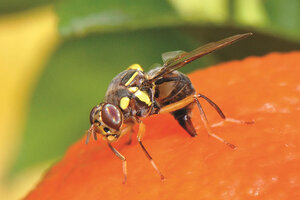Scientists catch fruit fly disguising itself as four distinct species
Previously thought to be four distinct species, the Oriental fruit fly has now been reclassified as one, potentially boosting pest control efforts.

Scientists have determined that the Philippine, Asian Papaya, Invasive, and Oriental fruit flies are actually all the same species.
Ana Rodriguez
Like a master of disguise, a species of fruit fly has proven adept at playing the impostor.
What scientists have for two decades believed to be four distinct species – the Philippine fruit fly, the Asian Papaya fruit fly, the Invasive fruit fly, and the Oriental fruit fly – are actually all the same, a discovery that could help boost pest control measures and eliminate an unnecessary barrier to trading goods.
Last year, researchers found that the Philippine and Asian Papaya fruit flies were indistinguishable. This week, a United Nations-backed study published in the journal Systematic Entomology, reveals that two more types – the Oriental and Invasive fruit flies – are genetically identical not only to each other, but also to the other pairing. All four will now be known as the Oriental fruit fly, or Bactrocera dorsalis.
In this most recent study, an international team of researchers marshaled data from molecular, behavioral, cytogenetic, and morphological sciences, among others to pull together evidence proving that several of these species were genetically the same. The team also studied a fifth fly, the Carambola fruit fly, but determined that it is a distinct species.
Farmers around the globe regard the Oriental fruit fly, be it four species or one, as a menace. Arriving in Eastern Africa more than a decade ago, it has since expanded its presence to most other regions of Sub-Saharan Africa. In West Africa the damage has been particularly devastating: farmers saw crop losses of more than 50 percent in some commercial mango orchards.
Besides killing crops, the invasive species turns countries that these flies call home into undesirable trading parters in the international market.
"Those countries who are free of these species want to maintain their pest-free status in order to protect their agriculture," Rafael Argiles Herrero, technical officer for the FAO's Insect Pest Control Section, told the Monitor in an email.
So these countries force imported fruit to go through quarantines to make sure the invasive fruit flies don't enter the environment. But knowing that four of these species are indeed the same means that trade restrictions like quarantines can come down, at least between regions in which the pest is already present, like Africa and Asia.
Pinning down the identity of these fruit flies also makes the battle to bring down their population numbers a bit easier. One effective method of pest control is the Sterile Insect Technique, or SIT, where scientists release into the infected environment male flies that have been sterilized through radiation. The sterile males then mate with female flies existing in the wild, who then fail to produce offspring, allowing the population to gradually decline.
"The SIT can't be applied if mating compatibility between the sterile and wild flies has not been demonstrated," Argiles Herrero said.
But scientists found in the study that the four fruit flies interbreed freely, making SIT a far-reaching fix.
"Mass-produced sterile Oriental fruit flies can now be used against all the different populations of this major pest," said Argiles Herrero.
The benefits of correctly categorizing this fruit and better controlling its population can mean a lot more for affected countries than their potential trading partners.
"This outcome has major implications for global plant biosecurity, especially for developing countries in Africa and Asia," the study's lead author, Mark Schutze, of the Plant Biosecurity Cooperative Research Centre and the Queensland University of Technology, said in a release.
Countries impacted by Oriental fruit fly may save millions of dollars by avoiding more severe invasion, and individual farmers can find security in eliminating the possibility that the pest will destroy their harvests.

